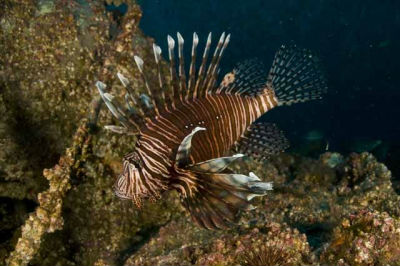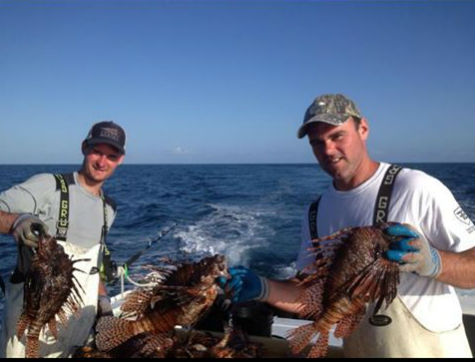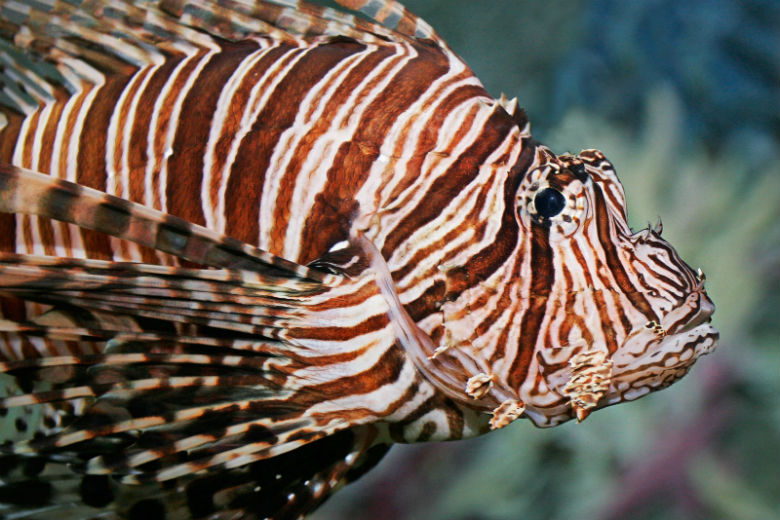First of two stories
More than a decade after finding lionfish established from off the North Carolina coast to Florida, marine researchers continue to look for ways to control the rapidly growing population of spiny, invasive species.
Supporter Spotlight
 Lionfish are an invasive species that have taken over local waters in recent years. Photo: Discovery Diving |
Management is imperative to protecting native fish along the southeastern Atlantic shore and Caribbean, experts say. Eradication is highly unlikely due to the fact that these hardy, hard-to-catch fish have no local predators.
James Morris, an ecologist with the National Oceanic and Atmospheric Administration’s National Centers for Coastal Ocean Science in Beaufort, said success stories are emerging about lionfish control in places around the Bahamas and Florida Keys.
“We do know that local control is possible,” Morris said. “There’s ten years of work that has gone into this effort and it’s exciting to hear how in, for example, the National Marine Park of Cozumel, local reef managers are intensifying local controls with great success.”
These ornamental fish, native to South Pacific and Indian oceans, have been popular pets in household fish tanks. Their release into the Atlantic Ocean and Caribbean now threatens native reef fish communities, including snapper and grouper. Lionfish are voracious eaters capable of thinning out populations of native fish.
Recent lionfish estimates report more than 1,000 lionfish per acre in some areas. The brown-and-white striped fish are currently invading the Gulf of Mexico and South America, according to the Center for Coastal Fisheries and Habitat Research.
Supporter Spotlight
Lionfish estimates off North Carolina range between 200 and 500 lionfish per 10,000 square meters.
In recent years, local efforts to dwindle the lionfish population off the North Carolina coast have been gaining momentum.
Earlier this month, the first annual “If You Can’t Beat ‘Em, Eat ‘Em” spearfishing tournament was hosted in Morehead City.
The 10-day event was a joint effort of Beaufort dive shop Discovery Diving, the Hampton Inn in Morehead City, the Eastern Carolina Artificial Reef Association, restaurant Bistro By the Sea and Carteret Catch.
About a dozen divers participated in the tournament, which ended June 9.
“We think for the first year we had a great showing,” said event coordinator Janelle Fleming, a researcher with the University of North Carolina’s Institute of Marine Science. “We’re training scuba divers so they can go out and collect them.”
Divers must be careful when handling lionfish, which are covered in sharp, venomous spines.
Lionfish are ambush predators that like to hide and corner their prey, Fleming said. The fish are not generally caught on hook and line. They are slow fish, giving divers the advantage.
 Fishermen and their catch. It is important to handle lionfish carefully, because they have venomous spines. Photo: Discovery Diving |
Lionfish speared in the tournament were recently cooked and handed out by Bistro By the Sea owner Libby Eaton as free samples to people attending weigh-ins at the Big Rock Blue Marlin Tournament in Morehead City.
“They taste very much like a trigger fish,” Eaton said. “We usually encrust them in fresh herbs and then we grill them. When we get them we’ll put them on our menu. Hopefully with the dive season starting we’ll be able to get more on a consistent basis.”
Scuba-Now, a popular dive shop in Wilmington, plans to host a lionfish cookout following a lionfish tournament it will sponsor in July. The shops manager, Inman Campbell, said details about the event will be available on their web site in the coming weeks.
Similar tournaments, called lionfish derbies, have become popular in the past few years throughout the Caribbean and along Florida’s Atlantic coastline.
These derbies, which award diving teams for their catch, aim to reduce local lionfish populations and educate the public. Derby spectators get to watch scoring, taste free lionfish samples and watch filleting and dissection demonstrations.
Lionfish derbies are in some cases helping lower local lionfish populations, according to the Reef Environmental Education Foundation, or REEF.
Since REEF sponsored its first derby in Green Turtle Cay, Abaco, Bahamas in 2009, more than 10,000 lionfish have been removed from the Caribbean and Atlantic.
Upwards of 3,000 lionfish have been removed from one derby.That number is significantly higher than the 250 or so lionfish taken during the tournament in Morehead City.
 Watch out, here they come. Photo: commons.wikimedia.com |
“Actually we didn’t really put a dent in the population that was there,” Fleming said.
Perhaps one way to control the lionfish population off North Carolina is to create a commercial fishing industry for the fish, she said.
On June 12, the Florida Fish and Wildlife Conservation Commission temporarily waived the recreational license requirement for divers harvesting lionfish. People are allowed to take as many of the fish as they can. The new rules will expire Aug. 3.
Discovery Diving, with assistance from NOAA, is testing whether or not Maine lobster traps may be an effective way of capturing lionfish off North Carolina.
“We started working with traps about seven or eight years ago,” Morris said. “Trapping a lionfish is very difficult because you get a lot of other fish in the traps. It’s the bycatch of other fish that’s the problem with traps.”
Unfortunately, Morris said, there aren’t any good control options for North Carolina because the hard-bottom reef habitat off the coast makes getting to lionfish more of a challenge than in shallower reefs. He said years of work are required to determine whether traps are a plausible option for North Carolina.
Tom Jackson, an invasive species expert with NOAA’s Miami office, gives this analogy: think of the lionfish invasion like that of cockroaches in a home.
“It’s a situation where we have a pest that’s reproducing at a high level,” Jackson said. “The first lionfish came to the U.S. in 1931 to the Chicago Aquarium. We’ve had this fish for 80 years and only in the last five have we begun to understand its reproductive habits. The problem with lionfish is this: They’re on the rocks, so there’s no great way to net them. Then you’re talking about doing it by hand. If they’re reproducing 10 to 20 times the number of eggs than a cockroach in a year, how are we going to control the replenishing population? If we can’t get cockroaches out of our house, how are we going to get them out of our ocean? It’s a real problem.”
Lionfish have been documented in water as shallow as three feet and as deep as 1,000 feet below the ocean’s surface. How, Jackson asks, can population control possibly be effective?
“I wish we had a magic bullet,” he said. “The solution from my perspective is future generations. The more we focus on teaching them to not release pets, the better off we’re going to be in the long term.”







